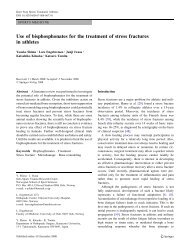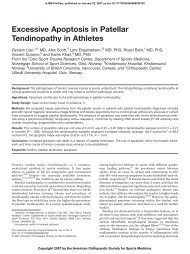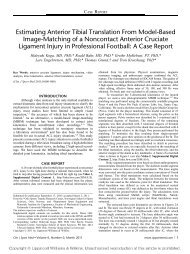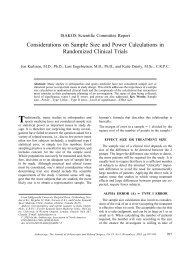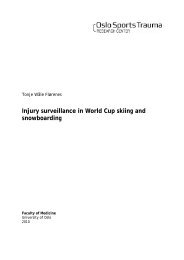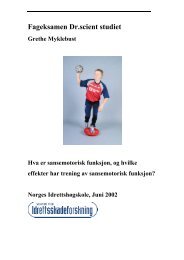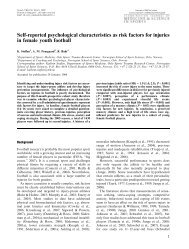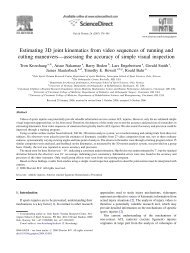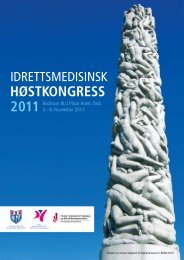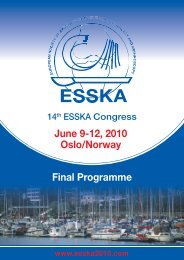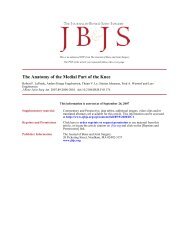ECSS Position Statement 2009: Prevention of acute sports injuries
ECSS Position Statement 2009: Prevention of acute sports injuries
ECSS Position Statement 2009: Prevention of acute sports injuries
Create successful ePaper yourself
Turn your PDF publications into a flip-book with our unique Google optimized e-Paper software.
Downloaded By: [Steffen, Kathrin] At: 02:55 10 June 2010<br />
230 K. Steffen et al.<br />
loading directions, magnitudes, and rates (Krosshaug,<br />
Andersen, Olsen, Myklebust, & Bahr, 2005).<br />
The biomechanical mechanisms for non-contact<br />
ACL <strong>injuries</strong> are widely debated. The two most<br />
discussed theories involve the quadriceps drawer<br />
mechanism and valgus loading. Proponents <strong>of</strong> the<br />
first theory argue that ACL <strong>injuries</strong> result from<br />
loading in the sagittal plane only, primarily as a<br />
result <strong>of</strong> anterior shear forces caused by forceful<br />
quadriceps contraction when landing or cutting<br />
(Yu & Garrett, 2007). This mechanism was demonstrated<br />
in a cadaver study (DeMorat, Weinhold,<br />
Blackburn, Chudik, & Garrett, 2004), but was<br />
criticized for not taking ground reaction forces into<br />
consideration. Others argue that knee abduction<br />
must be involved in the injury mechanism (Quatman<br />
& Hewett, <strong>2009</strong>). This theory is partly based on<br />
video analyses <strong>of</strong> ACL-injured athletes where<br />
valgus or valgus collapse are frequently reported<br />
(Krosshaug et al., 2007a; Krosshaug, Slauterbeck,<br />
Engebretsen, & Bahr, 2007b; Olsen et al., 2004).<br />
The combination <strong>of</strong> external rotation and valgus can<br />
possibly result in femoral notch impingement (Fung<br />
& Zhang, 2003).<br />
Furthermore, anterior tibial translation induced<br />
by a high tibi<strong>of</strong>emoral compression and tibial plateau<br />
inclination has been proposed as a possible loading<br />
mechanism (Meyer & Haut, 2008). Internal rotation<br />
<strong>of</strong> the tibia on a relatively extended knee is suggested<br />
as an ACL injury mechanism by cadaver studies<br />
(Markolf et al., 1995), by athlete interview studies<br />
(Myklebust, Maehlum, Holm, & Bahr, 1998), and<br />
by video analysis (Olsen et al., 2004). However, to<br />
make conclusive statements on the mechanisms <strong>of</strong><br />
non-contact ACL <strong>injuries</strong>, new, sophisticated methods<br />
<strong>of</strong> video analysis (Krosshaug et al., 2007a)<br />
combined with other research approaches such as<br />
clinical studies and cadaver simulation or mathematical<br />
simulation studies are needed (Krosshaug et al.,<br />
2005).<br />
The mechanisms <strong>of</strong> knee <strong>injuries</strong> in alpine skiing<br />
and snowboarding are likely to be different from<br />
those in team <strong>sports</strong> and at least among recreational<br />
skiers. According to Ettlinger and colleagues<br />
(Ettlinger, Johnson, & Shealy, 1995), the two main<br />
mechanisms are the so-called ‘‘phantom foot’’ (i.e.<br />
internal rotation in deep flexion due to canting <strong>of</strong> the<br />
inside edge <strong>of</strong> the tail <strong>of</strong> the ski) and the ‘‘bootinduced<br />
anterior drawer mechanism’’.<br />
<strong>Prevention</strong><br />
Injury prevention programmes have been developed<br />
to reduce the risk <strong>of</strong> ligamentous knee <strong>injuries</strong> in<br />
general, and ACL <strong>injuries</strong> in particular (Hewett,<br />
Ford, & Myer, 2006a; Renström et al., 2008). They<br />
are generally based on the assumption that modifying<br />
the dynamic biomechanical risk factors can<br />
prevent <strong>injuries</strong>. Successful prevention programmes<br />
alter the dynamic loading <strong>of</strong> the knee joint through<br />
neuromuscular training. Based on the likely injury<br />
mechanisms, it is recommended that athletes avoid<br />
knee valgus and land with knee flexion to absorb<br />
landing forces (Hewett, 2006a; Krosshaug et al.,<br />
2007a; Renström et al., 2008). Training programmes<br />
that incorporate plyometrics aim to result<br />
in safe levels <strong>of</strong> valgus stress to the knee and<br />
alterations in neuromuscular control patterns<br />
(Hewett et al., 2006a). As shown in several welldesigned<br />
intervention studies from soccer and team<br />
handball, programmes incorporating one or more<br />
exercise components to modify dynamic control <strong>of</strong><br />
the lower limbs have resulted in remarkable reductions<br />
in the risk for ACL <strong>injuries</strong> (Gilchrist et al.,<br />
2008; Mandelbaum et al., 2005; Myklebust et al.,<br />
2003) or lower extremity <strong>injuries</strong> (Olsen et al., 2005;<br />
Soligard et al., 2008; Pasanen et al., 2008). Balance<br />
training alone, and all homed-based training without<br />
instruction and feedback on proper movement<br />
technique (lower limb alignment, two-feet landings),<br />
is probably not as effective as when it is combined<br />
with other types <strong>of</strong> neuromuscular exercise stimuli<br />
(Hewett et al., 2006a; Söderman, Werner, Pietila,<br />
Engström, & Alfredson, 2000).<br />
Evidence from research on alpine skiers shows that<br />
an educational programme to increase awareness <strong>of</strong><br />
and modify behaviour in high-risk situations can<br />
prevent ACL <strong>injuries</strong> (Ettlinger et al., 1995).<br />
Ankle<br />
Injury characteristics<br />
An <strong>acute</strong> lateral ligament injury to the ankle (ankle<br />
sprain) represents the dominant injury type in many<br />
<strong>sports</strong>. Most ankle sprains result in an absence from<br />
training and competition for not more than a week.<br />
Nevertheless, because they are so common in many<br />
<strong>sports</strong>, ankle sprains account for a substantial part <strong>of</strong><br />
the total injury load. In female youth soccer, for<br />
instance, up to 40% <strong>of</strong> all <strong>injuries</strong> are ankle sprains<br />
(Le Gall, Carling, & Reilly, 2008; Söderman,<br />
Adolphson, Lorentzon, & Alfredson, 2001; Steffen,<br />
Andersen, & Bahr, 2007), and in volleyball they<br />
account for up to 50% <strong>of</strong> all reported <strong>injuries</strong> (Bahr<br />
& Bahr, 1997; Verhagen et al., 2004). From a public<br />
health perspective, ankle sprains therefore constitute<br />
a large part <strong>of</strong> the medical costs due to <strong>sports</strong> <strong>injuries</strong><br />
(Verhagen, van Tulder, van der Beek, Bouter, & van<br />
Mechelen, 2005).



